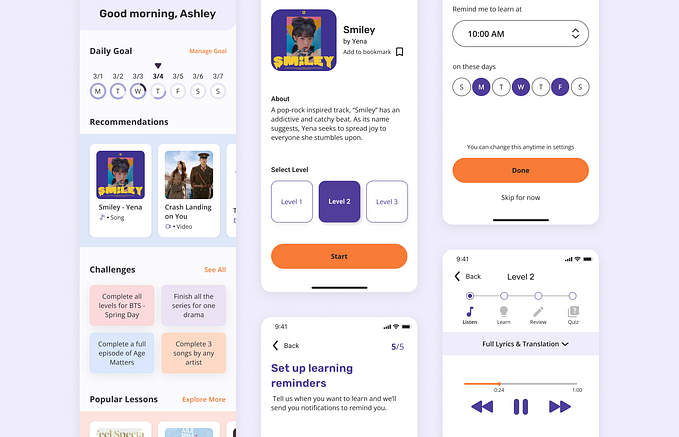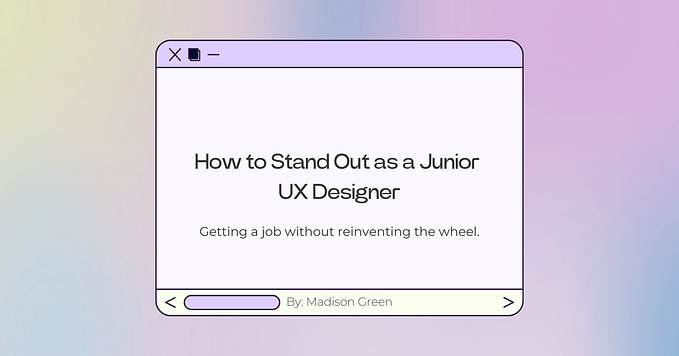The UI/UX portfolio: 13 best practices
Here is a list of my top 13 best UI/UX portfolio practices after 150+ hours of designing, 3 iterations, feedback from 10 industry professionals & 2 recruiters, researching a myriad of books, posts and one (rather basic) seminar.

NOTE: UI and UX are two different fields but the truth is, most companies do not have the resources to hire for both positions. You can use the following points for both/either specializations and adapt them to suit your prospective employer!
1. Everything on the Home Page.
Your future employer has very little time to hone in on how you will bring value to their enterprise. Remember to SHOWCASE THE UNIQUE VALUE YOU BRING.
The Apple homepage is a great example of how to use your homepage for maximum impact.

→ Don’t make them go down a rabbit hole! Lay everything out front and center on the home page. This way, the manager/recruiter has to do little imagining to evaluate your worth.
2. It Takes Two
You only need two solid case studies to land a job. More is not necessarily better.
Start by creating two solid case studies and really make them exciting.
3. Don’t Make Me Click!
No matter where in the portfolio, limit the number of clicks it takes to get somewhere. [This is, after all, a best UX practice.]

→ One way of balancing your employer’s interaction with each case study is by leading with what you think they would want to see first.
You can do this on your homepage by strategizing your layout to include:
(1) Your introduction
(2) Your skillsets
(3) An index of your work
(4) Links
For your case studies:
(1) A high-level overview of your case study
(2) Your proposed solution
(3) A chronological explanation of your process
→ Use graphics to visually segment your content.
4. KISS: Keep it Simple. Take Your Time.
It takes time to create simplicity. Bezos said the following about creating a great memo:
“ … they mistakenly believe a high-standards, six-page memo can be written in one or two days or even a few hours, when really it might take a week or more! […] The great memos are written and re-written, shared with colleagues who are asked to improve the work, set aside for a couple of days, and then edited again with a fresh mind. They simply can’t be done in a day or two.” Bezos: A CEO Who Can Write by Jean-Louis Gassée.
Bezos is right. Great work takes iterations.

→ Your journey of creating your dream portfolio should include several drafts interspersed with multiple rounds of feedback.
5. Tell Me a Story.
Lead with your problem/premise. Wrap them up in what excited or led you to your design choices. Tell them what you learned.

6. Typography
Study how to use harness typography for effective content layout. A great example of an excellent typography layout is Medium. Look below at how the headers, sub-headers, body and quotes are determined and spaced on medium.
Header
Sub-Header
Body
Quote
7. Why? Why? Why?
Why do you want to be a UX Designer? What impassions you? Why do you want to work for certain companies? Why did you choose a project? Why did you use a certain process over another? Why did you chose a certain font/layout? Why did you stop at a certain point?

8. Express Passion and Curiosity.
By providing enough whys, you are already showing great thinking abilities. You can show passion through your extra curricular activities.
Do you have a great Behance/Dribble/Reddit page? Do you have an instagram focused on design strategy? Are you a part of a design MeetUp in your locality? Are you a mentor? Do you have a LinkedIn page full of endorsements and testimonials? Did you just win first place at a design hackathon?

9. Think Like a Recruiter.

Get those key words in there. Recruiters do one thing: they scan. Why? Because they have hundreds of candidates on their to-do list and have no reason to be especially attentive to your portfolio. So how do you make your work easy to scan?
(1) Large Bolded Titles
Let large & bolded titles break your content, often. Kind of like how medium writers (like me in this article) break their articles into segments for quick consumption. This allows the reader some breathers and a chance to grasp what you are trying to convey without digging into heavier paragraphs.
(2) Clear Nomenclature
Let your titles speak for the content block that follows it. Paragraph titles give you an opportunity to provide high-level milestones, think points and explain processes in less than a sentence. This is not the the best place for cool, interesting titles. If the title doesn’t explain what is following it, most people will consider it unnecessary and move on.
(3) Negative Space
Use negative space to let your content scream of your design prowess! How? Negative space instantly allows content to pop. Without spacing, the content can seem complex and alarming. [Think: Reddit] Spacing allows for better highlighting of what you consider important. Here’s a good article that teaches you the basics of using negative space.
(4) Adaptive Content
Here’s the bad news: most people are looking at your resume while they are in motion. Having a non-adaptive portfolio website is a sure-shot way to frustrate them and make them wonder if you know what’s happening in the real world. If you’re using a template from companies like Squarespace or Wordpress, always check if your selected template is adaptive. This will save you a lot of hassle and heartache later.
[Sad story: This February, I lost 3 weeks of work after getting feedback that my website didn’t look good on mobile devices. I realized to my dismay that my basic template, which I thought was adaptive, didn’t adapt on mobile devices well enough. This resulted in fragmented content blocks.]
Adaptive Content Quick Check: Click and drag your browser window often while designing. This way, you will be able to tell if the content blocks are aligning well.
10. Think Like a Manager.
Gillian Hayes, the director of the MHCID program at University of California, Irvine and the CEO of AVIAÂ, states,
“I look for something unique, something explanatory, and something that shows off the ability to solve thorny problems.”
Most hiring managers look for the prospective-employee’s design thinking and their ability to follow through a thought process. The ability to apply convergent and divergent thinking processes also ranks high up there.

If you use the above outline for all your case studies, you will show the ability to think through a design problem and be able to defend your design solution when being interviewed. [BONUS: It will make you reflect on why you chose a specific design route, which will in turn make you a better designer.]
11. Don’t Over-design.
This one is hard for me because I am a trained artist and I love to design and make things aesthetically pleasing.

12. Use Your UX Skills! Get Feedback.
With each draft of your website, get feedback! If you can build websites, you have every reason to flex those UX muscles in order to build your dream website. If not, you will be bound by the constraints of your template.
→ Either way, use those constraints as a framework for your design and then follow the [wireframe-feedback-reiterate-feedback- prototype-feedback-high-fidelity-prototype-feedback-publish] loop to get to your final portfolio.

13. Oversharing is Overkill.
Leave things to talk about during your job interview! If you have every single detail outlined in your portfolio, you might be oversharing. This again, is hard for me as I am so passionate about the work I do. It doesn’t help that I’m a writer and I love to write! The reason for this is that if you write too much, you might be setting yourself up for failure.

BONUS: Consider your Portfolio a Story of your Evolution. Keep Working on it.
Just because you’ve published your portfolio doesn’t mean that you can’t continue to refine it! As you apply for jobs, you may realize attributes that employers are looking for. This may spark rework. Never abandon your portfolio. As you create work, keep adding to it. This way, you’re always ready for a higher position and find ways of reflecting on the work you are currently buried in!

BEZOS: A CEO WHO CAN WRITE: https://mondaynote.com/bezos-a-ceo-who-can-write-2f368ee36599
NEGATIVE SPACE: https://www.creativebloq.com/art/art-negative-space-8133765 | https://1stwebdesigner.com/negative-space-design/
TYPOGRAPHY: http://freelancefolder.com/typography-essentials-a-getting-started-guide/ | https://web.archive.org/web/20161015175942/http://www.thinkingwithtype.com/ | https://www.creativebloq.com/typography/better-web-typography-few-simple-steps-5132803 | https://vimeo.com/ondemand/helvetica3

Liked what you read? Subscribe to keep my blog on your reading list!
It doesn’t cost you to clap but it does cost me to write… So click and hold that clap icon! Thank you!
Did I miss a best portfolio practice? I’d love to know! Comments below are waiting for your thoughts…








